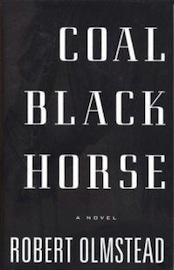A beautiful, despairing journey with a coal-black horse
 There’s a kind of myth-making happening in Robert Olmstead’s novel Coal Black Horse.
There’s a kind of myth-making happening in Robert Olmstead’s novel Coal Black Horse.
Published in 2007, I had the chance this past week to journey with the horse once more, and it was a trip well worth taking.
Set in the middle of the Civil War—itself a fertile era of American mythology—Olmstead’s story follows a fourteen-year-old boy sent from Virginia to find his father in the Confederate army and bring him home. “You must find him before July,” the boy’s mother tells him as she sends him on his quest.
And thus the myth-making begins.
Coal Black Horse feels every bit like the story of a Greek hero sent on an impossible quest, who learns along the way the deep reservoirs of perseverance and strength he possesses but never knew he had. It feels like an epic story passed down, through oral tradition, from generation to generation.
And if that’s all the novel was content to be, it would still be an interesting diversion. But what Olmstead crafts, instead, is a story that undergoes a metamorphosis along with is main character. As Robey Childs journeys from the wilds of rural western Virginia—and the wilds of his own youth—toward the harsh reality of war, the novel undergoes a subtle but powerful transformation of its own.
Robey comes from a world peopled by the kind of offbeat, slightly surrealistic characters you’d expect from a child’s imagination. There’s a hunchbacked blacksmith, an “upside-down boy” who walks on his hands, a man whose skin teems with lice. Robey’s mother is clairvoyant.
Even Robey possesses a touch of the fantastic. “On one night alone he grew an entire inch and when morning came he felt stretched and his body ached and he cried out when he sat up,” Olmstead writes. The result is a little like Mark Twain meets Homer.
This slight sense of surrealism—the way the world looks to an imaginative innocent—fades away the closer Robey gets to the armies. People lose their charm, they get grittier, they get bleaker. As Robey loses his innocence, so does the rest of the world.
Olmstead does not get gratuitous with his descriptions of battlefield violence, but he doesn’t shirk from the horrific experience of it, either. The war is grim. The world is grim. The book gets grim—but even at its most grim, the book never loses its poetic beauty. It’s as if Olmstead has infused his novel with truly beautiful writing as a way to refute the terrible things he has to write about.
For instance, one evening on the battlefield, Robey notices, “[a] heavy dew had fallen and the wetted field that stretched out before them beneath the moon was so like a wide path of white jewels on blue velvet.” Olmstead is a writer who appreciates the beauty of the world, and he takes time to supply readers with plenty of sensory descriptions.
The war is not incidental to the story, but Coal Black Horse isn’t really a war story. Robey’s journey doesn’t end at the battlefield. He must take his newfound knowledge—which might well be a curse—and learn to live with it. If the world is so grim, is there any place for beauty, for imagination, for innocence?
At the center of the story is the coal black horse the novel gets its name from. Olmstead sought to create an “iconic” figure from the horse—a task he succeeds at, perhaps too well. As any horse-lover knows, every horse has a distinct personality; in his effort to create an icon, Olmstead paints the horse in rough, stereotypical colors that fail to capture the horse as an individual. Maybe that’s the point. After all, in myth, icons matter more than individuals.
But Olmstead is smarter than that. He sends readers from one kind of myth to another and then, in the end, to someplace altogether different. It’s a journey both dark and beautiful, bleak and redemptive, haunting and resonant. Coal Black Horse is a myth of its own making—and you’ll feel its power on every page.
————
Cross-posted at Scholars & Rogues
This is a beautifully written review.
Just ordered it–thanks!